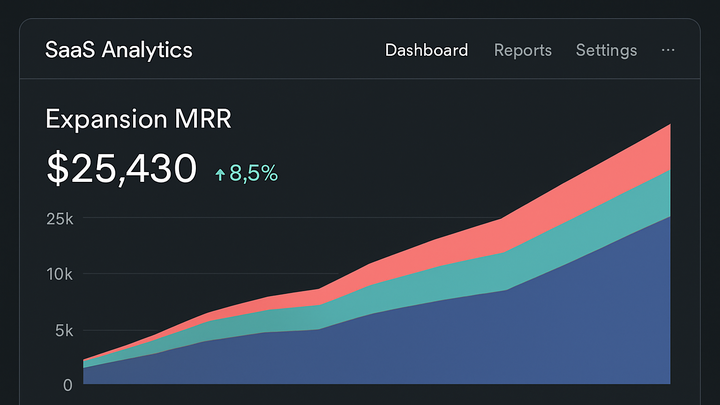Published on 2025-06-27T19:36:13Z
What is Expansion MRR? Examples and Importance in Analytics
Expansion MRR (Monthly Recurring Revenue) is a metric used in subscription analytics to measure the increase in revenue from existing customers due to upsells, cross-sells, or add-ons within a given month.
Unlike New MRR, which captures revenue from newly acquired customers, Expansion MRR focuses solely on upsell activities, making it a key indicator of account growth and customer satisfaction.
Tracking Expansion MRR helps SaaS companies understand product adoption, customer engagement, and the effectiveness of their sales and marketing strategies aimed at existing clients.
This metric directly feeds into Net MRR and Net Revenue Retention (NRR), providing insights into how well a business can grow its recurring revenue base beyond new sales.
By monitoring Expansion MRR alongside churn and contraction metrics, businesses can identify revenue trends, optimize pricing strategies, and forecast future growth more accurately.
Expansion mrr
Additional monthly revenue from existing customers via upsells, cross-sells, or add-ons.
Definition of Expansion MRR
This section defines Expansion MRR and explains its core components.
-
What is expansion mrr?
Expansion MRR represents the additional monthly recurring revenue gained from existing customers through upsells, cross-sells, or add-on purchases within a specific period.
-
Components of expansion mrr
- Upsells: Upgrades to higher-tier subscription plans.
- Cross-sells: Sales of complementary products or modules.
- Add-ons: Usage-based or feature-based enhancements.
Why Expansion MRR Matters
Highlights the importance of Expansion MRR in evaluating customer growth and overall business health.
-
Indicator of customer success
Growth in Expansion MRR signals strong product adoption, satisfied customers, and effective account management.
-
Boosts net mrr
Positive Expansion MRR directly increases Net MRR, helping to offset losses from churn and contraction.
How to Calculate Expansion MRR
Describes the formula for Expansion MRR and walks through an illustrative example.
-
Calculation formula
Expansion MRR = Sum of all MRR increases from existing customers (upsells + cross-sells + add-ons) during the period.
-
Example calculation
If Customer A upgrades by \(200 and Customer B adds a \)50 feature, Expansion MRR for the month = \(200 + \)50 = $250.
-
Tracking Expansion MRR with Analytics Tools
Instructions for instrumenting events in GA4 and PlainSignal to capture Expansion MRR accurately.
-
GA4 implementation
Create a custom event (e.g.,
subscription_upgrade) with a parametervalueset to the additional revenue. Use a user property likecustomer_status = existingto isolate Expansion MRR events. -
PlainSignal setup
Integrate PlainSignal for privacy-friendly, cookie-free analytics and capture upsell events. Example tracking code:
-
PlainSignal tracking code
<link rel="preconnect" href="//eu.plainsignal.com/" crossorigin /> <script defer data-do="yourwebsitedomain.com" data-id="0GQV1xmtzQQ" data-api="//eu.plainsignal.com" src="//cdn.plainsignal.com/plainsignal-min.js"></script>
-
Best Practices and Common Pitfalls
Offers tips to ensure precise measurement of Expansion MRR and highlights frequent mistakes to avoid.
-
Best practices
- Standardize event names and revenue parameters.
- Sync analytics events with billing data for validation.
- Regularly audit event firing and value mapping.
-
Common pitfalls
- Double-counting revenue across overlapping events.
- Overlooking prorated or partial upgrades.
- Event delays causing discrepancies in monthly totals.
